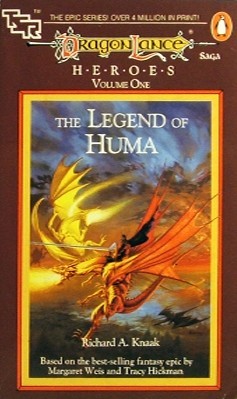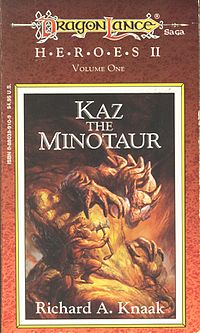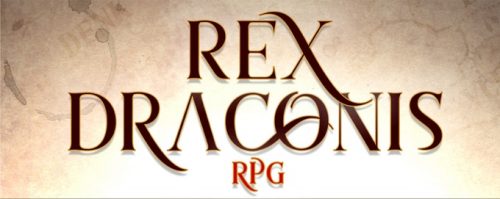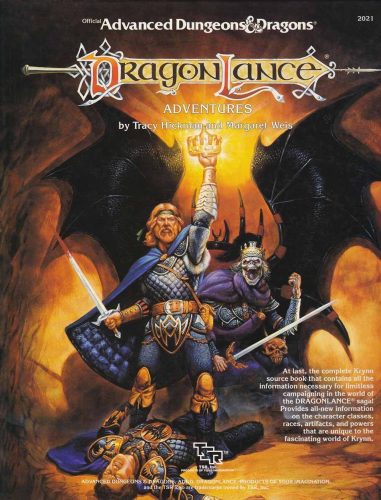
Advanced Dungeons & Dragons: Dragonlance. The world of Kyrnn. The continent of Ansalon. The Companions. Camaron. Raistlin. Takhisis. Paladine. Kitiara. Lord Soth. Chronicles. Legends. Margaret Weis. Tracy Hickman. The Legend of Huma. Kaz the Minotaur. Richard A. Knaak.
Those settings, characters, books, and authors summarize of my love for D&D’s Dragonlance. The setting was popular in AD&D, 2e, 3e, 3.5e, and the SAGA system (the last module, for 3.5e, was published in 2008 by Sovereign Press, one of Margaret Weis’ companies and the official licensor of Dragonlance at that time). Beyond the RPG books and sets there were tie-in novels published from 1984 until early 2010 (fellow Tessera Guilder, John McGuire, wrote about those early Dragonlance novels recently), comic books, video games, and a 2008 animated movie. While there was a tip of the hat in a 5e Unearthed Arcana to Krynn’s minotaurs (here), Wizards of the Coast has not published any new Dragonlance game material for a decade, and no new novels in nearing that time span.
While the full list of every author that touched Dragonlance over those two decades is extensive, the list of authors that most defined Dragonlance novels throughout their existence is four: Margaret Weis, Tracy Hickman, Douglas Niles, and Richard A. Knaak. Their prose gave the world its voice and structure, gifting it with flavor while crafting a complex history. Everyone involved did an excellent job of building the world of Krynn into one of D&D’s premier settings. Knaak built up the world’s history while cementing the sailor minotaurs and Knights of Solamnia and other critical facets of the world. He curved out a section of Krynn that might be dubbed “his” part of Ansalon. However, the downside of working on corporate properties is when the publisher stops producing them, your contract ends, and the sun on your part of the world sets, sometimes forever.
Knaak worked on other properties (World of Warcraft, Conan, Diablo, and several of his own series including Dragonrealm), yet the stories of Dragonlance must have continued to percolate in his mind. In 2017, he delivered the first book in a new fantasy series, Rex Draconis. The first novella, Rex Draconis: Under the Dragon Moon, lays out the opening shots of the series. I didn’t read Rex Draconis: Under the Dragon Moon, instead I did the Audible as read by Julie-Ann Amos. For those not versed in audiobooks, an Audible is the same as reading, only it’s not. Julie-Ann Amos elevated the work through her voice acting. Her characters had a life and presence that you do not hear in every audiobook and are not always present in your head as you read.
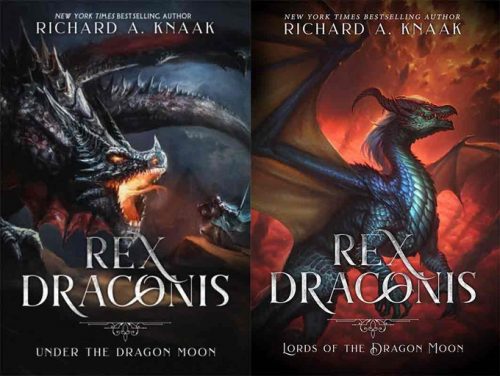
The superficial bits of the novella marked the series as the spiritual successor to Dragonlance. But, it’s not a cloned-Krynn, it’s a skillful homage to Knaak’s corner of Ansalon. A love letter so compelling that it’s inspired Knaak to work with Phil Beckwith of P.B. Publishing and Micah Watt of Pyromaniac Press to convert this prose into a tabletop RPG setting for D&D 5e and Pathfinder 1e (the Kickstarter for is live here until Sun, October 21 2018 10:02 PM EDT). I covered the Kickstarter here, and interviewed Knaak and the rest of the creative team on the Open Gaming Network.
What is Dragonlance about this series? Sailor minotaurs. Kwillum, a kender-like species that make more sense than kender. Two species of dragonfolk that have a light resemblance to draconians. Three-ish moons of differing hues. There’s more that, once you see those parts, make the other pieces fit a jigsaw puzzle of a Larry Elmore Dragonlance painting, but on examination it feels more like forcing the pieces to fit. The semi-befuddled mage, Knights of the Shield/Knights of the Grey Hand, the prominence of the gods as components of the sky, the tinker dwarf. Those pieces could be viewed as being taken from Ansalon, yet powerful mages, knightly orders, gods, and steampunk humanoids are common fantasy tropes. It is only when the other pieces are invoked that they form the tapestry of Krynn.
Despite the elevator pitch that this is Dragonlance revisited, and some similarities, Rex Draconis is not Dragonlance. Taken as a whole, it is its own world. The minotaur empire is pushing against the human’s world, the “orcs” of this world are the wheyr, a race of jackelpeople who have massive numbers and, thanks to some captured and copied minotaur ships, are a threat at sea, dragonfolk aren’t rooting for an evil goddess or defending mankind, instead, everyone are their pawns, the third moon is visible and shattered into the shape of a dragon, the kwillum are looking for something. There are layers to this world and this first novella offers a taste of each.
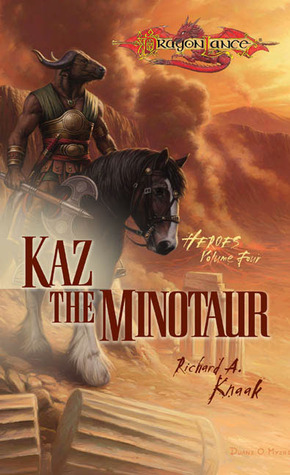
Who is Rex Draconis: Under the Dragon Moon for? Sword and sorcery fans. Fans of Richard A. Knaak. Fans missing their Dragonlance fix that are ok with a reimagined version of the world. D&D fans that want the feel of those worlds back in print. But mostly fans looking for a fantasy world that is fully realized, with interesting takes on the battle between good and evil, one where the series is ongoing and being transferred across medias to work with D&D 5e and Pathfinder 1e on Kickstarter (here).
Find Richard A. Knaak’s Rex Draconis: Under the Dragon Moon here.
UPDATE: The second novella in the series, Rex Draconis: Lords of the Dragon Moon, is available here.
Try the Audible here.
Support the Rex Draconis RPG – Rising Tides Kickstarter, which ends on Sunday, October 21 2018 10:02 PM EDT, here.
Richard A. Knaak, author of Dragonlance novels for over 20 years:
- Dragonlance: The Legend of Huma (1988)
- Dragonlance: Kaz the Minotaur (1990)
- Dragonlance: Land of the Minotaurs (1996)
- Dragonlance: Reavers of the Blood Sea (1999)
- Dragonlance: The Citadel (2000)
- Dragonlance: Minotaur Wars: Night of Blood (2003)
- Dragonlance: Minotaur Wars: Tide of Blood (2004)
- Dragonlance: Minotaur Wars: Empire of Blood (2005)
- Dragonlance: Ogre Titans: The Black Talon (2007)
- Dragonlance: Ogre Titans: The Fire Rose (2008)
- Dragonlance: Ogre Titans: The Gargoyle King (2009)
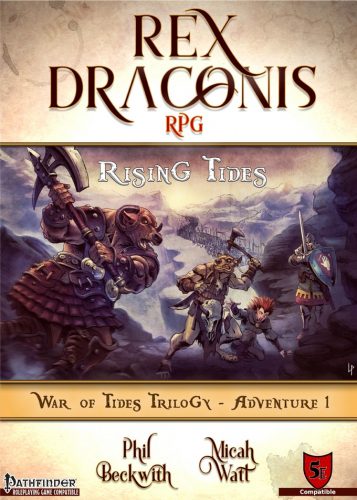
Along with two decades of Dragonlance short stories and novelettes:
- Dragonlance: Tales I: Wayward Children (1987)
- Dragonlance: Tales I: Definitions of Honor (1987)
- Dragonlance: Tales I: By the Measure (1987)
- Dragonlance: Tales II: Colors of Belief (1992)
- Dragonlance: Tales II: Into Shadow, Into Light (1992)
- Dragonlance: Tales II: The Hand That Feeds (1992)
- Dragonlance: The Dragons Anthologies: Kaz and the Dragon’s Children (1994)
- Dragonlance: The Dragons Anthologies: The Son of Huma (1997)
- Dragonlance: Tales of the Fifth Age: Sword of Tears (1998)
- Dragonlance: Tales of the Fifth Age: The Thief in the Mirror (1999)
- Dragonlance: Tales of the Fifth Age: Tactics (2000)
- Dragonlance: The Search for Magic: Tales from the War of Souls vol I: Hunger (2001)
- Dragonlance: The Players of Gilean: Tales from the World of Krynn: A Matter of Honor (2003)
- Dragonlance: The Search for Power: Dragons from the War of Souls: Loyalty (2004)
- Dragonlance: Dragons of Time: The Vow (2007)
* * * * * *
Disclosures: This article contains affiliate links.
Egg Embry, Wanna-lancer™
Freelancer for EN World, Knights of the Dinner Table, Open Gaming Network, and the Tessera Guild.
Want your RPG Kickstarter reviewed? Want to share news? Press releases? Rumors? Sneak peeks? Deals? Have some RPG wanna-lancer thoughts to share? Contact me here or on Facebook (Egg Embry) or on Google Plus (+Egg Embry).










